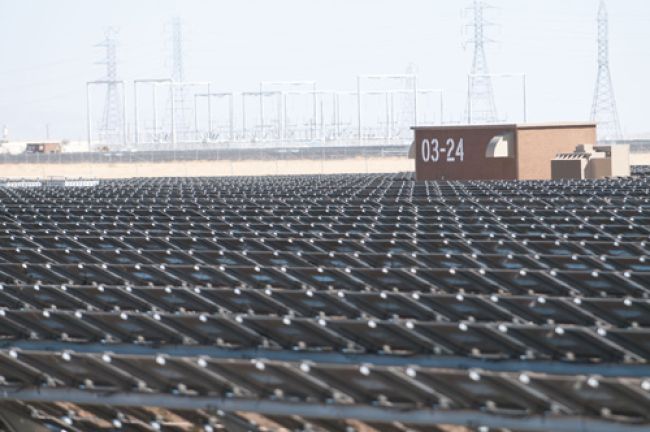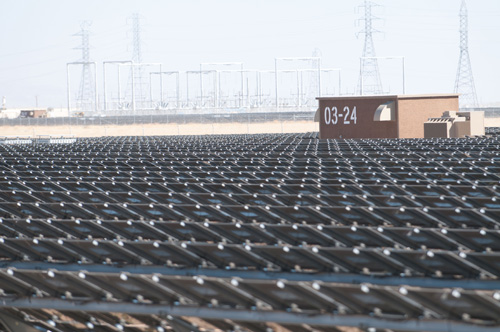
Photovoltaic Solar Safety Management for Utilities

Most people who have worked in the electric utility industry are familiar with the safety concerns and applicable safety regulations associated with conventional nuclear and fossil electric power generation. Over the past several years, however, there has been an increase in the number of new generating facilities constructed across the U.S. that incorporate renewable technologies such as solar, wind and biomass. This article will provide a basic overview of one of these technologies – utility-scale photovoltaic (PV) solar – along with discussion of related safety considerations.
PV Fundamentals
It is estimated that on a bright, sunny day, the sun’s rays give off approximately 1,000 watts of energy per square meter of the planet’s surface. PV technology utilizes a process that converts that sunlight directly into electricity. In fact, PV derives its name from the process of converting light (photons) to electricity (voltage).
To generate electricity, PV technology relies on substances known as semiconductors. Semiconductors are insulators in their pure form, but are capable of conducting electricity when heated or combined with other materials.
A semiconductor mixed or “doped” with certain materials develops an excess of free electrons. This is known as an n-type semiconductor. A semiconductor doped with different materials develops an excess of spaces or holes that accept electrons. This is known as a p-type semiconductor.
The PV module is manufactured so that thin films of n-type and p-type materials are deposited on a glass substrate and then joined together with a layer between them called a “junction.” When the PV module is exposed to sunlight, photons from that light dislodge a large number of electrons, which then flow from the n-type semiconductor across the junction to the p-type semiconductor, generating a direct electrical current.
Generally speaking, the generation of electricity from PV solar is safe, effective and environmentally friendly. PV generation facilities do not burn fossil fuels and therefore do not produce the greenhouse gas emissions associated with conventional facilities. For a large PV facility, say 500 megawatts (MW), this factor can equate to the displacement of some 337,000 tons of carbon dioxide annually, the equivalent of removing 73,000 cars from the road.
Basic PV Plant Design
A typical PV facility is designed with the following major components: PV modules, direct current (DC) combiner box, power conversion station (inverter), step-up transformer and interconnect system to the grid.
Individual modules are installed end to end upon a metal frame with electrical connections made in series. These connected modules are referred to as a “string.” Several strings are installed, one on top of another, to create a row. The electrical cables from each string in the row are connected in parallel and bundled together to form a harness.
Harnesses from several rows are then joined together in a DC combiner box where, as the name suggests, the direct currents from the individual harnesses are combined to produce a single positive and negative output cable. The output cables run to an inverter where the DC produced by the modules is converted into alternating current (AC). The AC continues through a step-up transformer so that power can finally be sent out onto the grid for consumer use.
PV facilities range in size from less than a single MW to in excess of 500 MW. The construction of a PV generation facility is modular in nature, meaning that a specified number of rows are connected together and then run to an inverter and associated transformer. This configuration is referred to as a “block,” where each block is capable of producing a set amount of power. To construct a larger-rated site, you need to install more blocks to reach the total desired power output.
Site Safety
PV facilities look and operate differently than nuclear and fossil facilities. The first thing that you’ll notice when visiting a PV facility is that there doesn’t appear to be anything going on; in fact, the site looks and sounds very serene. PV modules lay quietly across the site, basking in the sunshine, gathering in as much light as possible to convert it into electricity.
There are no water or steam systems at work, no running pumps, valves or piping, and no spinning turbine or generator. There are essentially no moving parts at all. Because of this design, many of the safety hazards typically associated with conventional generation simply do not exist.
However, the serenity at the site can be somewhat deceptive because real hazards do exist – they simply aren’t as readily apparent.
A major safety consideration at a large PV facility is associated with its geographic size. For example, a 500-MW facility can cover an area of some 3,500 acres, which equates to a site of more than 5 square miles. The simple act of driving from one side of the site to the other can take 10 to 15 minutes. A site of this size requires careful safety assessment, planning and preparation. Imagine having an accident or injury somewhere on the site and having to call for assistance. How is communication of a situation like this going to be handled, and what type of response is required?
To address these questions, an emergency action plan should be created that includes an initial site-specific communication assessment to ensure that adequate radio or cellphone reception is available across the entire site. On a site where radio and cellphone service are unavailable or not reliable, it is wise to provide workers with satellite GPS messenger devices. These devices can be set up to notify site management, the operations center and even off-site emergency services in the event of an emergency. With the simple press of a button, the devices not only send notification of an emergency, but they also provide location information to ensure a prompt response to the incident area.
Heat is another safety consideration that must be managed. Many PV facilities are located across the Southwestern U.S. deserts where summer temperatures can reach well over 110 F. If not properly addressed, these high temperatures have the potential to cause heat-related injury and illness to workers in the field. To combat this condition, the implementation of a heat illness prevention plan (HIPP) is highly recommended. First Solar, which currently operates some of the world’s largest grid-connected PV power plants, uses HIPPs on all of its sites. The company’s HIPP was developed based on the requirements of Section 3395 of Title 8 of the California Code of Regulations, “Heat Illness Prevention” (www.dir.ca.gov/Title8/3395.html); the OSHA Technical Manual, Section III, Chapter 4, “Heat Stress” (www.osha.gov/dts/osta/otm/otm_iii/otm_iii_4.html); and the U.S. Army Center for Health Promotion and Preventive Medicine’s Work/Rest/Water Consumption Table (www.rucker.amedd.army.mil/assets/documents/pdf/WorkRestTable.pdf).
The key element of First Solar’s HIPP is the utilization of wet-bulb globe temperature (WBGT) readings on-site to determine heat-related risk. During high heat conditions, WBGT monitors are placed at work locations and regularly monitored. Specific safety guidance is administered based on specific WBGT levels. This guidance includes placement of required shade areas, recommendations for worker water consumption and guidelines for worker break periods.
Electrical Safety
As with any facility generating power, electrical safety is of the highest priority. Applicable safety regulations such as OSHA 1910.269, the NESC, and NFPA 70E are used at PV facilities to provide guidance in developing safety policies and procedures.
One major difference with solar generation is that the primary on-site electrical system is associated with the production of DC. Whenever sunlight strikes a PV module, DC is being generated, and with the possibility for millions of modules on-site, that is a lot of potential exposure.
The safety concern to be addressed with this design is that there is no easy way to remove or isolate the source of power (sunlight) from the modules for maintenance work during plant operating hours.
The good news is that the same condition that creates the hazard during the day provides a means to safely deal with it at night. Every evening as the sun goes down, the fuel source – and thereby the system power – is removed from the DC system. One of the unique features of solar generation is that there is a scheduled outage every night. This provides the opportunity to perform required maintenance work at night and virtually eliminates the need to perform any energized work on DC equipment.
As for the AC system, similar to traditional generation, the equipment that requires maintenance can be electrically isolated utilizing a lockout/tagout program so that electrical shock and arc flash hazards are removed.
Safety Training, Policies and Procedures
To ensure the safety of workers at a PV facility, a robust system of safety training, policies and procedures must be established.
First, a training needs analysis should be conducted for all work performed at the facility. Based on the work activities and the hazards associated with that work, a training matrix can be developed. This matrix should identify the safety training requirements for each type of worker. Typical training classes include OSHA standards, NESC and NFPA 70E electrical and arc flash safety, lockout/tagout, first aid and CPR, human performance improvement and project-specific safe work rules.
Additionally, equipment technical training should also be conducted to ensure that workers have a thorough understanding of the operations, maintenance and safety hazards associated with each piece of equipment they work with.
It’s critical that safety-related policies and procedures – such as those regarding lockout/tagout, confined space entry, respiratory protection and fall protection – be in place to provide clear instructions for dealing with anticipated site hazards. Based on OSHA requirements, a job hazard assessment and pre-job briefing procedure should also be in place to assist in identifying and addressing all work-related hazards prior to the beginning of each work activity. The application of human performance principles such as procedure use and adherence, stop-think-act-review, peer-checking, flagging and three-way communication is also recommended to reduce the number of accidents caused by human error.
By design, PV facilities have far fewer safety hazards to deal with than conventional generating sites, but hazards do exist and accidents can happen. To achieve outstanding safety performance at PV facilities, workers must be tenacious in identifying hazards and assessing risks, relentless in addressing them, and diligent in their efforts to guard against both worker and organizational complacency.
About the Author: Jeff Court, CUSP, is the regional EHS manager for First Solar. He previously held several roles at Arizona Public Service, including plant operator and operations adviser at the Palo Verde Nuclear Generating Station, and safety manager for the transmission-distribution and sales organizations.
Editor’s Note: If you’d like more information about this topic, Jeff Court, CUSP, will present “Solar Technology and Safety Management for Utilities” on November 3 at the iP Utility Safety Conference & Expo. Visit www.incident-prevention.com to register.

